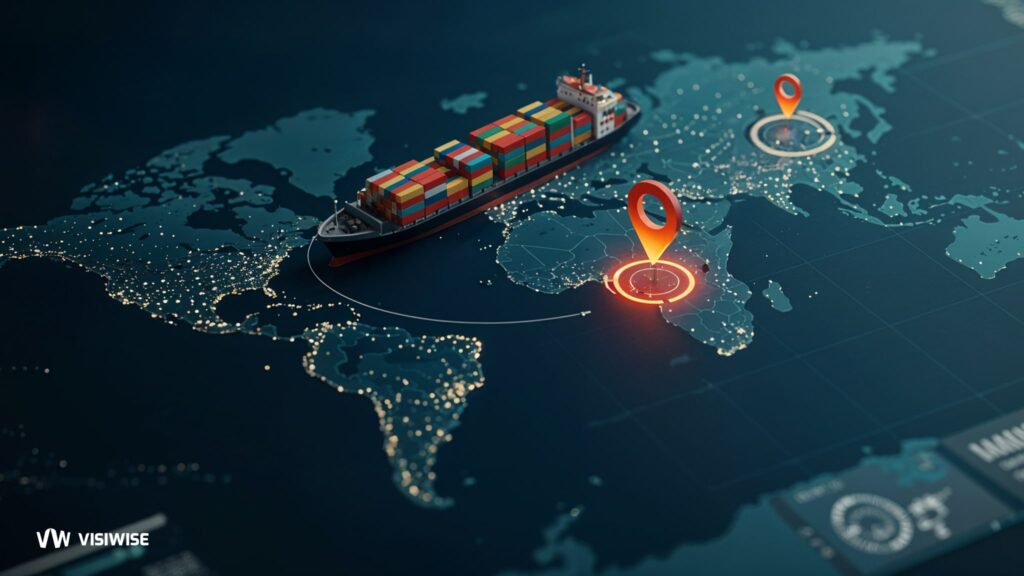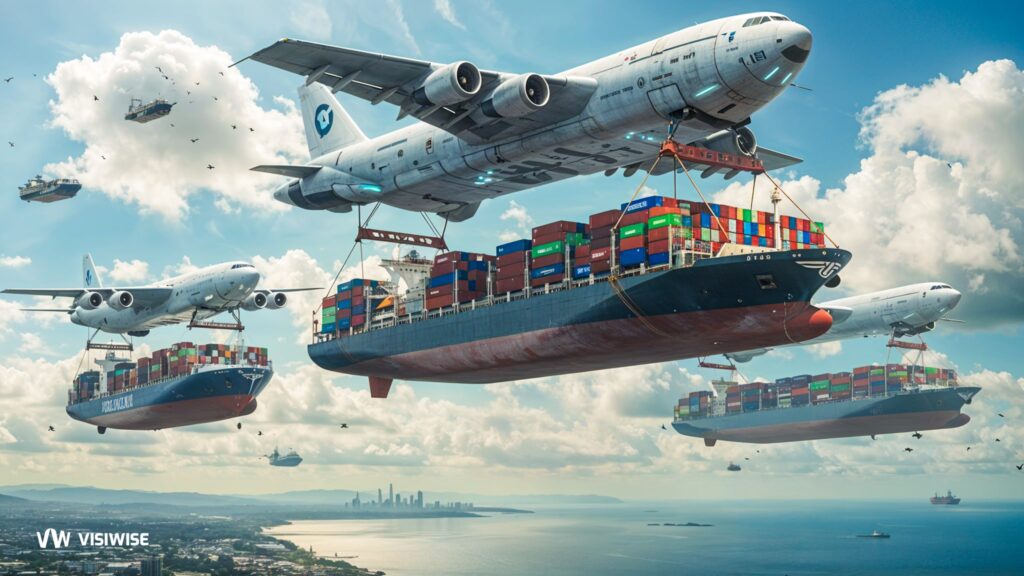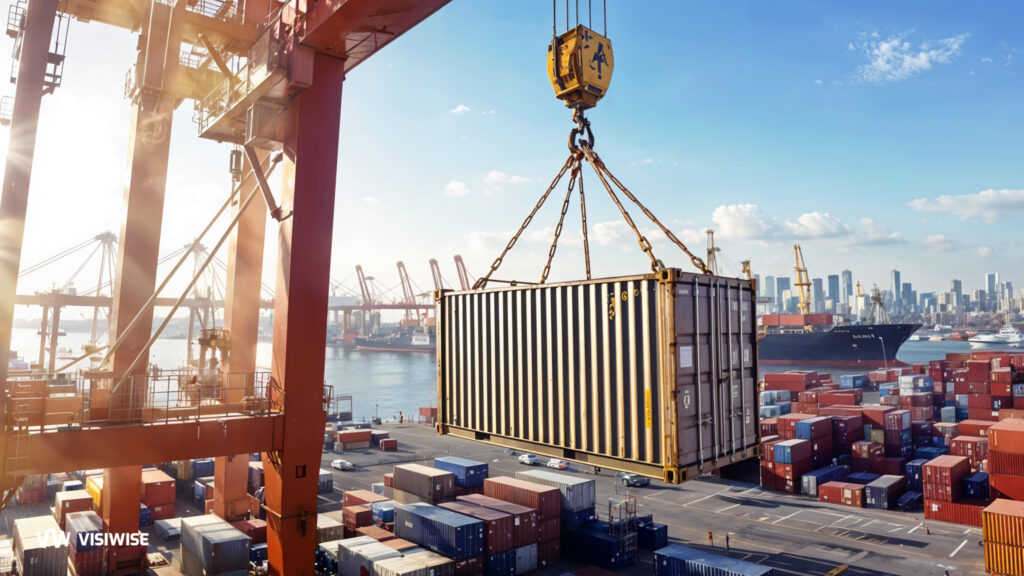As the shipping industry grapples with its significant contribution to global greenhouse gas emissions (GHG), accounting for approximately 3%, alongside exacerbating water and underwater noise pollution, sustainability has emerged as a critical priority. Achieving sustainability in sea transportation demands active engagement from all stakeholders. Shippers, in particular, hold considerable responsibility in this endeavor, necessitating a thorough grasp of the challenges and increased visibility into the environmental footprint of their shipments. Additionally, this article will explore the role of biofuels as a potential solution to mitigate GHG emissions in the shipping industry.
The Impacts of Maritime Transport Worldwide
The impacts of maritime transport worldwide are multifaceted and encompass various aspects such as the environment, society, and economy. Merchant ships engaged in trading play a crucial role in these impacts. However, despite their importance, several challenges arise that must be addressed to ensure the sustainability, efficiency, and competitiveness of maritime transport.
Ecological Impact of Ocean Transportation
Greenhouse Gas Emissions
Ocean transportation is a major contributor to greenhouse gas emissions, exacerbating climate change. In 2021, emissions totaled 833 million metric tons of CO2e (carbon equivalent), including carbon dioxide (CO2), methane (CH4), and nitrous oxide (N2O).
Impact of Marine Heavy Fuel Oil
Marine heavy fuel oil, containing approximately 86% carbon, significantly adds to CO2 emissions. Burning one ton of fuel releases about 3.15 tonnes of CO2 into the atmosphere.
Regulatory Measures and Targets
To address this, the International Maritime Organization (IMO) aims to reduce the carbon intensity of international shipping by 40% by 2030 and decrease GHG emissions from ships by 50% by 2050 compared to 2008 levels. This necessitates stakeholders to cut down on fossil fuel usage and explore alternative energy sources like liquefied natural gas (LNG), hydrogen, solar, and wind power.
Environmental Impacts Beyond Emissions
Apart from emissions, ocean carriage of goods poses other environmental concerns:
Underwater Noise
Transportation activities generate underwater noise, affecting marine ecosystems and wildlife.
Oil Spills and Pollution
The risk of oil spills during transportation poses a threat to marine ecosystems, leading to pollution and adverse effects on the environment.
Mitigation and Sustainable Practices
To mitigate these impacts, shipbuilders and operators are implementing various strategies:
Quieter Vessel Design
Efforts are underway to design quieter vessels by incorporating noise-reducing technologies such as electric propulsion, special coatings, and optimized propellers.
Sustainable Practices
Practices like slow steaming, which optimizes vessel speed to reduce noise emissions, are being adopted to promote sustainability in ocean transportation.
Impact on Society
The global shipping industry sustains millions of jobs, both ashore and at sea, spanning various roles within shipping companies, ports, logistics, and related maritime services. Moreover, maritime transportation plays a pivotal role in delivering essential commodities like food, energy, and raw materials to communities worldwide. Nonetheless, the presence of ships and ports can lead to adverse social consequences for neighboring communities, such as increased traffic congestion and pollution of air, water, and noise.
Moreover, attention is drawn to concerns regarding the working conditions of individuals employed in the sector, emphasizing the imperative of ensuring their safety, health, and overall well-being. The International Maritime Organization (IMO) has established comprehensive international regulations and standards aimed at safeguarding the welfare of seafarers. Among these regulations, the SOLAS Convention (International Convention for the Safety of Life at Sea) stands out as a pivotal agreement addressing the safety of vessels engaged in international voyages, including merchant vessels. Its scope encompasses various aspects such as vessel construction, equipment standards, safety management practices, and emergency protocols.
Furthermore, shipping companies are obligated to combat illegal activities that may occur onboard vessels.
Economic Impact
Seaborne transportation stands as a cornerstone of economic prosperity in numerous nations, fostering job creation and facilitating the expansion of international trade. In regions such as the European Union, it constitutes a staggering 80% of both imports and exports by volume and approximately 50% by value. Its contribution to the global GDP is estimated to range between 2% to 3%.
Nonetheless, shipping companies face substantial expenses related to vessel operations, upkeep, repairs, and regulatory compliance. To maintain competitiveness and satisfy the escalating demand for maritime transport services, they must continually pursue strategies to streamline operations, curtail costs, bolster safety protocols, and enhance overall customer satisfaction.
Visibility on the Impacts
Having visibility on the impacts of their activities is crucial for shipping companies for several reasons:
- Identifying Improvement Areas: It allows them to pinpoint areas where they can enhance their carbon footprint and social responsibility efforts. By understanding the effects of their operations, they can identify opportunities for improvement and implement targeted strategies to reduce negative impacts.
- Informed Decision Making: Visibility enables companies to make informed decisions that balance operational efficiency, cost reduction, and environmental protection. Armed with comprehensive data on the consequences of their actions, they can make strategic choices that optimize their operations while minimizing adverse effects on the environment and society.
- Monitoring Sustainability Initiatives: It enables companies to closely monitor the effectiveness of their sustainability initiatives and make necessary adjustments to their supply chain management practices. By tracking the outcomes of their efforts, they can assess what works, what doesn’t, and refine their approaches accordingly, leading to more effective and sustainable practices.
With a clear understanding of how their actions impact communities and the environment, companies can develop appropriate strategies for mitigating negative effects and driving positive change. However, achieving visibility on these impacts poses a significant challenge for the maritime industry due to the complexity of factors and data involved. Moreover, the industry encompasses various stakeholders across the global supply chain, including shipbuilders, shipping lines, carriers, logistics service providers, port authorities, regulators, and environmental organizations.
Therefore, it is imperative for shipping companies to collaborate with these stakeholders, leverage advanced technologies for data collection and analysis, and adopt transparent reporting practices to enhance visibility on their environmental and social impacts. By taking an active role in reducing the environmental footprint of the global supply chain, shipping companies can contribute to the collective effort to address climate change and promote sustainability.
Elevating the Role of Shippers in Sustainable Maritime Transportation
Despite their significant role in the global supply chain, the environmental impact of maritime carriage is often underestimated concerning shippers. As pivotal stakeholders, shippers bear a responsibility to embrace sustainable practices and minimize emissions and waste.
To fulfill this responsibility, shippers can undertake the following measures:
Identifying Improvement Areas: Understanding the impact of operations allows companies to pinpoint areas for enhancing their carbon footprint and social responsibility efforts. This insight enables the identification of improvement opportunities and the implementation of targeted strategies to reduce negative impacts.
Informed Decision Making: Visibility provides companies with comprehensive data on the consequences of their actions, enabling informed decisions that balance operational efficiency, cost reduction, and environmental protection. Armed with this information, companies can make strategic choices to optimize operations while minimizing adverse effects on the environment and society.
Monitoring Sustainability Initiatives: Visibility enables companies to closely monitor the effectiveness of their sustainability initiatives and adjust supply chain management practices accordingly. By tracking outcomes, companies can assess effectiveness, refine approaches, and promote more sustainable practices. Optimizing freight operations, reducing empty miles, and minimizing packaging usage can significantly save costs for shippers on freight rates and materials. Additionally, utilizing a visibility platform like Visiwise can further enhance their ability to access and analyze this data, allowing for more informed decision-making, improved operational efficiency, and better management of their carbon footprint.
Artificial Intelligence (AI)
AI is a potent tool facilitating the analysis of extensive datasets and the detection of patterns that might elude traditional analytical methods. Sinay offers a suite of AI-based modules tailored to assess underwater noise, water quality, and air quality in a user-friendly format. By deploying suitable sensors, shippers can monitor various indicators and consolidate data on a centralized dashboard.
Additionally, Sinay offers a range of APIs enabling professionals in the maritime sector to develop specialized solutions linked to their own ERP or their clients’ internal tools. This digital platform facilitates real-time tracking, analysis, and reporting on shippers’ environmental performance, encompassing factors like fuel consumption and emissions.
Internet of Things (IoT)
Connected devices can be strategically deployed on various equipment and installations to gather data on emissions and other environmental factors. This data is then transmitted in real-time to a centralized shore-based system for analysis, providing shippers with enhanced visibility into their environmental impact and enabling them to make more informed operational decisions.
Big Data Analytics
The sheer volume of data generated across the entire supply chain can be overwhelming. Therefore, companies must invest in advanced analytics and data management tools to effectively harness this wealth of information.
Big data analytics represents a significant advancement in analyzing the extensive data collected from IoT devices, satellite data, and reports from third-party specialists like Sinay. For instance, the Metocean Analytics tool serves as a prime example of a management tool in this regard.
By integrating information from these diverse sources, shippers can gain valuable insights into their environmental performance and pinpoint areas for enhancement.
Blockchain
Blockchain technology holds the promise of establishing a secure and immutable record of a product’s carbon footprint, spanning from its origin to its destination. This comprehensive record includes emissions and other crucial metrics. Such heightened transparency and accountability have the potential to encourage greater collaboration among diverse stakeholders within the shipping industry.
Transportation Management System (TMS)
A Transportation Management System (TMS) serves as a vital tool for numerous entities within the logistics ecosystem, including shippers, warehouses, supply chain managers, customs brokers, transportation intermediaries, and carriers. This automated platform provides real-time end-to-end visibility into various aspects of their operations, enabling them to optimize shipment management and enhance supply chain efficiency.
Employing a TMS offers a multitude of advantages to supply chain leaders like Amazon, as well as to small and medium-sized enterprises (SMEs):
- Real-Time Monitoring: Shippers can track the location and condition of their shipments in real-time, receive alerts about potential delays, and adjust plans accordingly. This ensures streamlined operations with minimal dwell time.
- Enhanced Customer Service: Shippers can furnish accurate and timely information to end customers regarding shipment status and estimated arrival or delivery times (ETA or ETD), thereby ensuring superior customer service.
- Comprehensive Visibility: Shippers have access to 360° visibility of freight rates, transit times, and carrier performance. This information facilitates informed decision-making regarding shipment consolidation and route optimization, leading to substantial cost savings.
- Error Avoidance: Automated processes within the TMS help prevent errors arising from manual intervention and mitigate supply chain disruptions, ensuring smoother operations.
The utilization of a TMS empowers stakeholders across the logistics spectrum to streamline operations, optimize resources, and deliver superior service to customers.
Future Prospects: Biofuels in Shipping
The Getting to Zero Coalition is dedicated to expediting the decarbonization of shipping by introducing commercially viable deep sea vessels with zero emissions powered by zero emission fuels by 2030. This initiative aims to set shipping on a trajectory for complete decarbonization by 2050. To explore various fuel and technology options that could facilitate the shift towards zero emission fuels, the Fuels & Technologies workstream has organized a series of webinars. These sessions have gathered insights from experts spanning the maritime value chain, including shipowners, operators, charterers, financial institutions, classification societies, and NGOs. The briefing paper series, designed to disseminate insights to a wider audience, seeks to establish a shared understanding of the fuels, engines, and storage technologies pivotal in enabling the transition towards decarbonization.
Overview:
Biofuels emerge as a leading contender among existing alternatives for zero-emission fuels, boasting advanced technological readiness. Currently utilized in various forms—including drop-in fuels like HVO (hydrotreated vegetable oil), blend-in fuels like FAME (fatty acid methyl ester), and as alternative fuels in specialized engines such as biomethanol—their sustainability and scalability are still evolving. Nevertheless, relative to non-bio zero-carbon fuel options, biofuels offer promising supply availability. Their viability for shipping hinges on factors like scalability, sustainability, and cross-industry demand, notably from aviation. Critical considerations include meeting sustainability criteria and securing certifications as shipping transitions towards decarbonization.
Key Takeaways
- Sustainability criteria and appropriate certification can ensure that potential negative impacts of biofuels are not shifted elsewhere along the supply chain.
- There is no silver bullet for scalable zero emission shipping fuels, and biofuels can play a role in the long term transition pathway, offering the flexibility of an interim drop-in solution or as a zero emission pilot fuel for e-ammonia or e-methanol.
- It is important to keep in mind that investment choices are fostered by the spectrum of impact along the supply chain and across industries.
Opportunities and Challenges of Biofuels
Opportunities:
- Flexible Transition: Sustainable biomass offers the flexibility to create drop-in fuel options or blends, facilitating the transition to alternative fuels.
- Sustainability: Establishing a framework with common standards is essential to ensure that biofuel production avoids negative environmental and social impacts. Currently, there are biomass-related sustainability regulations, standards, and certification schemes based on robust criteria. However, harmonization of these rules and certification schemes is needed to streamline the process.
Challenges:
- Market Response: The scalability of biofuels poses a risk, as long-term competition may drive shortages in sustainable biomass availability, impacting market response.
- Competition: Industries such as aviation and energy sectors are also interested in using biomass and biofuels for their transition, potentially leading to price increases due to high demand.
- Lifecycle Emissions: While many biofuels are considered zero or near-zero emission options, they are primarily sourced from biomass, biowaste, or recycled vegetable oils. It’s essential to consider the full emission lifecycle upstream in the supply chain and during the combustion process to accurately assess their environmental impact.
Biofuels as Sustainable Transportation Solutions
Biofuels, such as ethanol and bio-based fuels, represent transportation fuels derived from biomass materials. While frequently blended with conventional fossil fuels like gasoline and diesel, these fuels can also be utilized independently. The Getting to Zero Coalition embraces a broad definition of "zero carbon energy sources," encompassing fuels produced from biomass, zero carbon electricity, or fossil fuels coupled with carbon capture and sequestration technology.
The Challenges of Producing Biofuels Without Shifting Negative Impacts Elsewhere in the Supply Chain
a. Scalability Challenges
Scaling sustainable biofuel production presents numerous hurdles, as highlighted in a recent webinar. Ensuring that fuel production genuinely reduces greenhouse gas emissions without introducing negative environmental or social impacts upstream is essential. Conducting a thorough life-cycle analysis is necessary to determine the sustainability and scalability of bio-based feedstocks.
b. Sustainability Criteria
Carolina Grassi, Policy and Innovations Manager at the Roundtable for Sustainable Biomaterials (RSB), emphasized the importance of sustainability principles and criteria in addressing these challenges. To overcome these obstacles, credible and robust sustainability criteria should be established. These criteria must meet technical and economic requirements while preventing adverse environmental and social impacts and promoting positive outcomes. The RSB, in collaboration with stakeholders from various sectors and regions, has developed a sustainability framework grounded in 12 Principles. These principles guide the production of fuel, biomass, and material products from bio-based and recycled carbon in an environmentally, socially, and economically appropriate manner. By addressing issues such as climate impacts, environmental conservation, and social development, the 12 Principles contribute to mitigating a wide range of potential impacts, including greenhouse gas emissions reductions, soil and water conservation, and human rights protection.
c. Assessment of sustainable biofuels
Voluntary sustainability frameworks like RSB, ISO, and ISCC are continuously evolving, with organizations offering certifications aligned with criteria set by professional associations, standards bodies, and government agencies. Market demand for certification is instrumental in driving the adoption of voluntary standards, influencing the supply of feedstocks and biofuels. Sustainability-related ISO standards provide frameworks developed by experts to support innovation and address global challenges.
Public policy plays a crucial role in mandating sustainable production and sourcing of blends, ensuring compliance with sustainability standards. While biofuels can help mitigate climate change by reducing lifecycle greenhouse gas emissions compared to fossil fuels, comprehensive measures are needed across production processes and supply chains to achieve significant emissions reductions.
Life Cycle Assessments (LCAs) employ robust methodologies to compare various biofuels and feedstocks across the supply chain, facilitating scalability and environmental performance improvements. Considerations include biomass competition between markets and the utilization of waste and residues, with innovative solutions like blockchain aiding in transparency and traceability.
Transition pathway
a. The roadmap
Berit Hinnemann, Maersk’s Head of Decarbonization Business Development, stressed the importance of a strategic decarbonization roadmap for the global supply chain. She emphasized the need to swiftly decarbonize operations to meet both technical and commercial customer expectations.
Maersk is implementing efficiency measures and transitioning from fossil fuels to renewables like biomass and renewable electricity to achieve net-zero emissions by 2050. They believe that biomass and renewable electricity will enable the production of advanced biofuels like biodiesel and bio-methanol, as well as green ammonia and lignin fuels. Maersk recognizes the availability and scalability challenges of biodiesel and is exploring hybrid methods for producing methanol to address these issues.
The company has ordered eight methanol-powered vessels, capable of running on biomethanol and e-methanol, considered scalable options for the long term. In the short to medium term, Maersk is considering a fuel mix of biodiesel and methanol. The first carbon-neutral dual-fuel engine container vessel running on methanol will launch in 2023, followed by eight additional vessels in 2024. However, the key challenge remains sourcing zero-emission fuels for these vessels.
b. Biofuel as a transition fuel
Goodfuels launched biofuel oil bunkering in 2018 and conducted the first biofuel trial for an ocean vessel in 2021. Johannes Schurmann, Innovation Manager at Goodfuels, emphasized the company’s commitment to offering sustainable, affordable, available, and technically viable solutions to customers. Recognizing that there are no one-size-fits-all solutions, Goodfuels provides various options in its portfolio tailored to different vessel needs.
Schurmann highlighted the importance of incentives to encourage investments and reduce costs while enhancing the scalability of biofuels through research and innovation in new processes, such as lignin-based fuels. Despite acknowledging the limited scalability of biofuels for shipping due to restricted feedstock supply and competition from other sectors, Schurmann suggested that biomass is currently available to initiate the transition, with a potential shift to e-fuels once sufficient green electricity becomes accessible.
Biofuels offer promise for meeting short-term CO2 reduction targets in shipping decarbonization. However, as production scales, there’s a risk of biomass shortages, requiring global standards and sustainability criteria. Despite challenges, biofuels serve as interim solutions and pilot fuels, playing a crucial role in current decarbonization efforts.
Final Thoughts
To create an environmentally and socially sustainable future for the shipping industry, shippers need visibility into the impacts of their activities, empowering them to take responsibility for their actions and make informed decisions. Meeting these challenges requires companies to invest in new technologies, such as automated visibility platforms. Additionally, the future of biofuels presents one option for taking action this decade to meet short-term CO2 reduction targets on the pathway of shipping decarbonization. While biofuels offer flexibility as an interim drop-in solution or as a zero-emission pilot fuel, their scalability poses potential risks due to shortages in sustainable biomass availability. To manage this risk effectively, global common standards and sustainability criteria are necessary to prevent shifting negative impacts up the supply chain.



